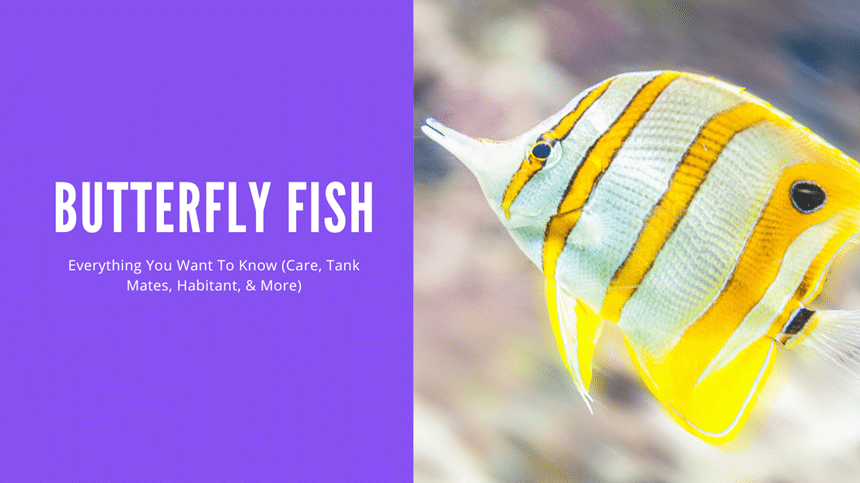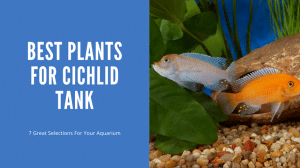Thank you for visiting! By the way… any links on this page that lead to products on Amazon and other stores/partners are affiliate links Aquarium Store Depot earns a commission if you make a purchase.
Butterflyfish species are one of the most intricately patterned fish that are both; beautiful and hardy. In the fish-keeping world, butterflyfish species look a lot like Angelfish, so novice aquarists often get confused. Saltwater butterflyfish species are gorgeous and exotic of all the reef fish because of their beautiful colors and unique patterns.
In this article, I’ll discuss everything about the 21 amazing types of butterfly fish species that will blow your mind instantly.
Stay with me!
Fun Facts And Takeaways
- There are around 130 Butterflyfish species spanning 12 genera1.
- There’s a black spot on the back of the butterflyfish to distract the predators.
- They live for around 10 years or longer.
- Butterflyfish are nocturnal; most active during the night and sleep through the day.
- They can change their colors automatically depending on the situation.
Let’s learn more exciting things about the different types of butterflyfish species individually.
The Top 21 Types of Butterfly Fish Species
Here are the 21 common types of butterflyfish species in the aquarium hobby. For each species, I’ll go over key states such as:
- Scientific Name
- Common Name
- Size
- Origin
- Tank Size
- Available As Tank Bred
We have a YouTube video from our official channel you can check out below. We go into more details in the blog post below. If you enjoy our content, be sure to subscribe.
1. Heniochus

- Scientific Name: Heniochus
- Common Name: Longfin Bannerfish, Bannerfish, Pennant Coralfish, Wimple Fish, Featherfin Coralfish, Coachman, Threadback, and Reef Bannerfish
- Size: 9.8 inches
- Origin: Pacific region and Arabian Gulf or Indo-west Pacific regions
- Tank Size: 55 gallons
- Available As Tank Bred: Yes.
Heniochus or the false Moorish Idol, also known as Longfin Bannerfish is an enchanting marine fish from the family Chaetodontidae. With a white base and two wide black stripes, the graceful patterns of this fish make it a real eye-catcher in the aquarium hobby. The dorsal fins and caudal fins are yellow with black marks above the eye area. The black and white species of Heniochus are reef-safe and prefer a meaty varied diet.
If you’re someone who is tempted to keep Moorish Idol in the tank, go for Heniochus as it is hardier and easy to care for in aquarium conditions.
2. Klein’s
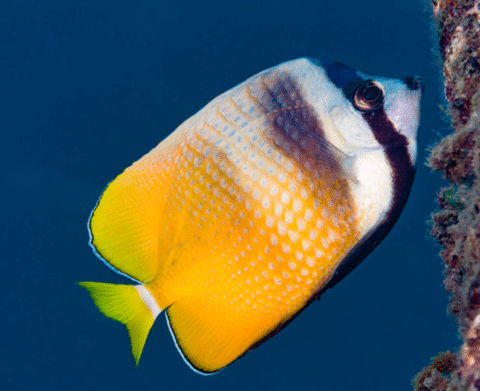
- Scientific Name: Chaetodon Kleinii
- Common Name: Sunburst Butterflyfish, Orange Butterflyfish, Bluehead Butterflyfish, Yellowspot Butterflyfish, and Brown Butterflyfish.
- Size: 5 inches
- Origin: Red Sea, in the Indo-Pacific and Eastern Pacific oceans
- Tank Size: 55 Gallons
- Available As Tank Bred: Yes
If you fancy a beginner friendly marine fish, I’d vote for Klein’s butterflyfish because it is small and easy to care for. Also, reasonably priced. In the wild, they grow to up to 6 inches in length. However, in captivity, they hardly reach 5 inches, provided that they are taken care of.
Appearance wise, they are not the typical flashy and vibrant butterflyfish species as their counterparts. Klein’s butterflyfish has an oval body with brownish yellow color and white bands that run vertically down their oval bodies. They have a protruding snout with a small mouth. Depending on their origin, there are color and pattern variations in the Klein’s fish.
3. Longnose
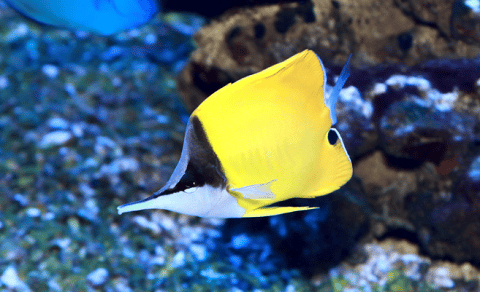
- Scientific Name: Forcipiger Flavissimus
- Common Name: Big nose butterflyfish, Forceps butterflyfish, Yellow longnose butterflyfish
- Size: 8.7 inches
- Origin: Indo-west Pacific and Central Pacific regions
- Tank Size: 75 Gallons
- Available As Tank Bred: Yes
The Yellow long-nosed butterflyfish have long snouts with strong jaws and a graceful appearance with their distinctive yellow fins and bodies.
The Yellow long nose fish are larger fish reaching over 8.7 inches in length. However, the added length is from the nose!
Because of their color, many aquarists believe they are delicate and fragile. However, it’s quite the opposite. Yellow long nose fish are relatively hardy with great appetite that usually won’t have problems eating in captivity.
But, they require a big tank of around 75 gallons with some live rock and lots of free swimming space. Nonetheless, they are a great community fish that are peaceful, hardy, and absolutely gorgeous.
4. Pyramid

- Scientific Name: Hemitaurichthys Polylepis
- Common Name: Yellow Pyramid Butterflyfish
- Size: Around 8 inches
- Origin: Hawaii, Indonesia, New Caledonia
- Tank Size:
- Available As Tank Bred: Yes
Want some golden ray of sunshine in your marine aquarium? Let me introduce you to the beautiful Pyramid butterflyfish.
They are peaceful and schooling fish in the wild. Therefore, a couple of fish in your aquarium would thrive together. These are medium sized fish around 5 to 6 inches in length, so you will need a larger tank to keep multiple.
The bodies of Pyramid fish are mostly white with a yellow or golden base color and dark bands or stripes running down vertically. Because of their small size, they have a small mouth with a short snout. The head is mostly brown in color with a broad, white pyramid-shaped pattern on the flanks.
This is also one of the few butterfly fish on this list that are truly reef safe. They are safe around corals and inverts. They eat plankton in the wild and will not seek our most corals.
Fun fact: They are shy fish. Therefore, provide as many hiding places as you can to make them comfortable in their new home.
5. Tinkeri
- Scientific Name: Chaetodon Tinkeri
- Common Name: Hawaiian butterflyfish, Tinker’s Butterflyfish
- Size: 5½ inches
- Origin: Tropical reefs around the Indo pacific oceanic regions
- Tank Size: 120 gallons
- Available As Tank Bred: Yes
Tinkeri or the Hawaiian Butterflyfish are attractive and rare sea creatures with shades of yellow and orange on the face, dorsal fin, and tail. The backs of Tinkeri are usually back with a yellow tail.
They inhabit shallow reefs and don’t appreciate intense lighting in the aquarium setting. Also, they require an aquarium of 120 gallons or more with lots of hiding places in the form of rocks, and caves.
Tinkeri Butterflyfish are not coral reef safe and should be administered with caution if kept in reef aquariums.
6. Threadfin

- Scientific Name: Chaetodon Auriga
- Common Name: Auriga Butterflyfish, Cross-stripe Butterfly, Whip Butterflyfish, Threadfin Coralfish, Diagonal Butterflyfish, and Yellow butterflyfish.
- Size: 9 inches
- Origin: Pacific Region
- Tank Size: 125 gallons
- Available As Tank Bred: Yes
Threadfin Butterflyfish can seem intimidating due to their huge size but they are the most peaceful fish species that are shy and timid. However, they can be aggressive with conspecifics and other species of the same size or color.
The visual aesthetics of Threadfin fish are a sight for sore eyes. They have a bright pearl white body on the front and bright yellow from the rear with several diagonal black lines, creating a masterpiece of a fish.
If you plan to keep it as a community fish, make sure to provide a huge tank to make up for their big size and energy levels.
7. Raccoon

- Scientific Name: Chaetodon Lunula
- Common Name: Crescent-masked Butterflyfish, Lunula Butterflyfish, Bandit Butterflyfish, Redstriped Butterflyfish, and Spotted Butterflyfish
- Size: 7.9 inches
- Origin: Indo-Pacific from East Africa to Hawaii, southern Japan, and the Lord Howe and Rapa Islands
- Tank Size: 75 Gallons
- Available As Tank Bred: Yes
As the name suggests, Raccoon butterflyfish has a mark on their face just like raccoons.
And like raccoons, these fish are famous for their nocturnal behavior, i.e., they stay active throughout the night time and hide during the daylight.
Raccoon butterflyfish are attractive species, especially due to their high-contrast bandit-type color patterns. The best part about these fish is they are easy to care for and appropriate for beginners. Therefore, if you’re looking for a beginner-friendly, fascinating marine fish, Raccoon fish ticks all the right boxes.
This is also a butterfly fish that is reef to use in SPS tanks. They will eat soft corals, but they are known by many hobbyists for not eating SPS corals.
8. Sunset
- Scientific Name: Chaetodon Pelewensis
- Common Name: Pelewensis Butterflyfish, Dot-Dash Butterflyfish
- Size: 4.9 inches
- Origin: Reefs of the South Pacific
- Tank Size: 55 Gallons
- Available As Tank Bred: Yes
Appearance wise, the Sunset butterflyfish resembles a lot of their close cousins: Spot-banded butterflyfish. However, Sunset butterflyfish have a brownish yellow body with deep brown bands running vertically throughout their bodies. Besides yellow coloration, they have an orange area on the caudal peduncle, an orange band edged by black through the eye, and a black spot on the nape. Hence, the name.
Even though hardy, Sunset butterflyfish are recommended for intermediate aquarists because of their varied diet requirements. These fish will gladly accept substitute fish foods along with a protein rich diet, including algae and live meaty foods. Furthermore, the water quality requirements of this fish are not as easy as a beginner friendly fish. Therefore, if you’re an experienced fish keeper, you will enjoy having Sunset butterflyfish in your fish tank.
9. Spotfin

- Scientific Name: Chaetodon Ocellatus
- Common Name: Butterbun, Common butterflyfish, Katy, School mistress
- Size: 3 to 6 inches in length
- Origin: Western Atlantic; found in the Bahamas, Gulf of Mexico, and the Caribbean.
- Tank Size: 125 Gallons
- Available As Tank Bred: Yes
You will normally find these saltwater fish in the sandy bottom around reefs in the Western Atlantic region. The Spotfin butterflyfish has beautiful oval white bodies with captivating yellow fins. At the base of their dorsal fin and face, there is a black bar that looks absolutely stunning combined with the hues of yellow and white.
In the wild, they usually feed on sea anemones and tube worms. Therefore, in captivity, you can feed them sponge based frozen foods and other live foods, live corals, and stony corals. So, if you’re not willing to get live corals for food, avoid this fish at all costs.
10. Pakistan
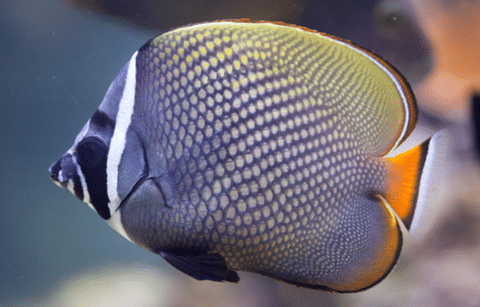
- Scientific Name: Chaetodon Collare
- Common Name: Red-tailed Butterflyfish, Collare Butterflyfish, or Redtail Butterflyfish
- Size: 7.9 inches
- Origin: Indian and Pacific oceans. Also, found in some regions of the Philippines and Indonesia.
- Tank Size: 75 Gallons
- Available As Tank Bred: Yes
Pakistan Butterflyfish are popular for their unique and ever-so-gorgeous red tail. Therefore, it is commonly known as the Redtail Butterflyfish.
The average size of these fish is around 7.9 inches. Therefore, it requires a large tank with lots of swimming space and hiding spots. The color and pattern distribution of this fish are incredible. With a chocolate brown body adorned with cross hatch pattern with golden and orange spots, this fish is a vision to behold in your marine aquarium.
However beautiful, Pakistan Butterflyfish are relatively challenging to keep in home aquariums as they are known to eat coral polyps and fan worms in their natural habitat. Therefore, they are best suited for experienced hobbyists.
11. Mitratus
- Scientific Name: Chaetodon Mitratus
- Common Name: Indian butterflyfish, black and yellow butterflyfish
- Size: 5.5 inches
- Origin: Western Indian oceans
- Tank Size: 55 Gallons
- Available As Tank Bred: Yes
Indian Butterflyfish will become your instant favorite as it is a moderately hardy, easy to care for, and peaceful fish. They will even come to the surface to accept food from their owners.
Mitratus have distinctive triangle shaped bodies with protruding a snout and small mouth. The dorsal fin is graced with a rounded tail fin that looks beautiful while swimming.
In the wild, they eat small invertebrates and planktonic animals. However, in captivity, they accept a varied diet with lots of meaty options like frozen foods, dried flakes, brine shrimp, live brine, mysis shrimp, and other foods. Young fish need more frequent feedings of specialized diet than adult fish. As a rule of thumb, feed your adult Indian Butterflyfish twice a day and juveniles, thrice a day.
12. Copperband
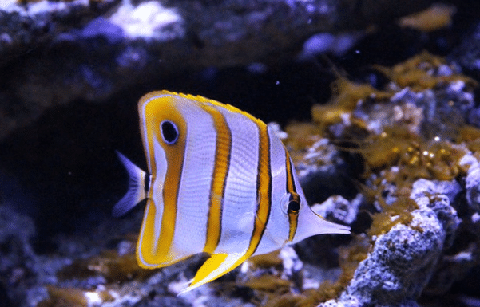
- Scientific Name: Chelmon rostratus
- Common Name: Copper banded butterflyfish, beaked coralfish
- Size: 7.8 inches
- Origin: Indo pacific region
- Tank Size: 70 Gallons
- Available As Tank Bred: Yes
Copper band butterflyfish have long snout, elegant form, and striking colors that catch attention instantly. They are known and used to help rid reef aquariums of aiptasia anemones (Racoons are known for doing the same).
Despite their small size, they need a spacious tank because of their activity levels in the open water. Also, they need lots of hiding places such as table corals where they can hide freely or lie motionless.
These fish can be challenging to keep for a beginner. Therefore, it is suitable for intermediate to advanced aquarists. There are tank bred species available now and I would highly recommend you find a vendor who has them, as they will adjust to an aquarium environment easier.
13. Golden
- Scientific Name: Chaetodon semilarvatus
- Common Name: Bluecheek butterflyfishes
- Size: 11 inches
- Origin: Western Indian Ocean: Red Sea and Gulf of Aden
- Tank Size: 100 Gallons
- Available As Tank Bred: Yes
Golden Butterflyfish are one of the most popular yet largest species found in the aquarium hobby. Despite their peaceful nature and large size, they are gorgeous with vibrant colors and swimming movements.
Luckily, these fish are moderately hardy and are can be kept by someone with experience. They accept a variety of foods including frozen foods, live foods, and other dried food options. However, a bigger tank with lots of hiding places is a prerequisite for Golden fish. They will happily eat any coral, so they are best in fish only tanks.
14. Black Back
- Scientific Name: Chaetodon Melannotus
- Common Name: Black-back, Blackback and Black-backed butterflyfish
- Size: 6 inches
- Origin: Indo-Pacific area from the Red Sea and East Africa to Samoa
- Tank Size: 120 gallons
- Available As Tank Bred: Yes
If you want to keep a black back butterflyfish, make sure it’s the only one in the tank (unless you can get a mated pair). Also, make sure the tank has numerous hiding places and lots of room to swim freely.
Black back butterflyfish have white bodies with black diagonal lines on the sides yellow fins and yellow faces. They swim gracefully with an intimidating demeanor that screams elegance. It is not reef safe and will consume corals.
15. Falcula
- Scientific Name: Chaetodon falcula
- Common Name: Blackwedged butterflyfish, Saddle Back Butterflyfish.
- Size: 7.8 inches
- Origin: Indian oceans
- Tank Size: 125 gallons
- Available As Tank Bred: Yes
The Falcula Butterflyfish are relatively hardy but semi-aggressive. Therefore, practice caution while keeping it with other fish. In nature, they eat invertebrates. Therefore, they thrive the best in a mature fish setup with lots of live rock and swimming space. Like many on this list, they are not reef safe and will eat just about any coral and even anemones you place in the tank.
16. Orange Margin
- Scientific Name: Prognathodes basabei
- Size: 5 to 6 inches
- Origin: Central and Western Pacific Oceans
- Tank Size: 75 Gallons
- Available As Tank Bred: Yes
With a disk-shaped body and pointed snouts, Orange Margin Butterflyfish are stunning, relatively small fish around 5 to 6 inches in length.
They are popular for their beautiful appearance and active nature. Generally kept in larger aquariums for no less than 75 Gallons.
17. Bank
- Scientific Name: Prognathodes Aya
- Common Name: Bank Butterflyfish, Doubleband Butterflyfish
- Size: 6 inches
- Origin: Western Central Atlantic: North Carolina and the northeastern Gulf of Mexico to Yucatan in Mexico; unknown in Bahamas and Antilles.
- Tank Size: 75 Gallons
- Available As Tank Bred: No
Bank Butterflyfish are beautiful, with striking patterns and vibrant coloration. Their white body is meticulously designed with yellow fins and dark bands on their body.
One of the most interesting things about Bank butterflyfish is their mating behavior in which once they find a suitable partner, they stay committed to them during breeding. It is a very expensive fish, often commanding a 4 figure price. They are considered reef safe with caution and they may pick or eat some corals.
18. Banded

- Scientific Name: Chaetodon striatus
- Size: 6.5 inches
- Origin: the Gulf of Mexico, the Caribbean, and the eastern central Atlantic Ocean close to St. Paul’s Rocks.
- Tank Size: 125 gallons
- Available As Tank Bred: No
They are super active Butterflyfish species and add a lot of movement and life to your tank. I also suggest keeping them in small groups since they are peaceful with fish of their sizes and colors. However, make sure to add a lot of hiding places in the form of live rocks, so they can hide if they feel threatened.
It is a peaceful fish that as a young fish will act as a cleaner fish eating parasites off other fish. It will eat corals and inverts so house them in a fish only tank.
19. Double Saddle

- Scientific Name: Chaetodon ulietensis
- Common Name: False Falcula Butterflyfish or Saddled Butterflyfish
- Size:6 inches
- Origin: Central Indo-Pacific region
- Tank Size: 120 gallons
- Available As Tank Bred: Yes
They are peaceful and hardy marine fish species that are loved by most aquarists. Double Saddle butterflyfish do great in pairs or alone. However, always introduce them into tanks that have been established for several months.
To keep them healthy and happy, feed them a varied diet, including mysis shrimp, clams, krill, bloodworms, commercially prepared food, and plankton. It should not be placed in a reef tank as it will eat soft and hard corals and anemones.
20. Arabian
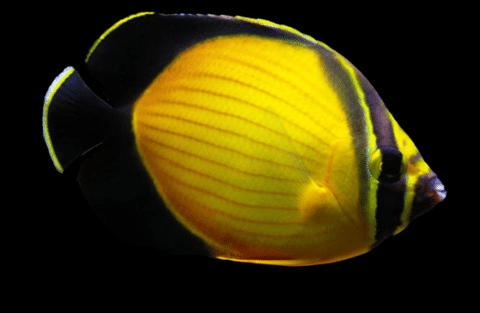
- Scientific Name: Chaetodon melapterus
- Size: 4 to 6 inches
- Origin: North Western Indian Ocean
- Tank Size: 55 Gallons
- Available As Tank Bred: No
Beautiful, small, bright yellow fish with a butterfly pattern that swims close to corals and feeds on invertebrates, algae, and plankton. Since they usually feed on coral polyps, they are not suitable for a reef tank.
They also will generally not survive in a tank without a steady diet of coral polyps to eat. If you can get them to eat prepared foods, they are relatively easy to keep. However, many will not. They are best for advanced aquarists and should be only purchased by a vendor that conditions their fish with a quarantine process to ensure they are eating before purchase.
21. Wrought Iron
- Scientific Name: Chaetodon daedalmahe
- Size: 6 inches
- Origin: Western Pacific Ocean, near central and southern Japan
- Tank Size: 70 Gallons
- Available As Tank Bred: No
As the name suggests, wrought iron butterflyfish (video source) is the most metallic of all the fishes that are fascinating and peaceful simultaneously. Since they can live in pairs or alone, you can keep a group of fish with similar size and temperament in the same aquarium without worry.
They are prized fish and rare. These fish will easily sell for over $2,000 online. They should only be purchased from a vendor that offers a guarantee and quarantines them, given their price tag.
Honorable Mentions
We only included 21 on this list but there are plenty others that you can keep. Here are a few we didnt’ mention that you can look up:
- Vegabond butterflyfish
- Teardrop butterflyfish
- Eastern triangular butterflyfish
FAQs
Are saltwater butterfly fish reefs safe?
Generally, no. Most species of butterflyfish are obligate coral feeders and feed on soft corals and gorgonians. Therefore, they are usually not reef tank safe. However, there are some species that are considered reef tank friendly, such as the Copperband butterfly, but nothing is 100%.
What size tank does a saltwater butterflyfish need?
Depending on the species, size, and age of the butterfly fish, the tank requirements are different. However, there’s no doubt that they require a bigger tank of no less than 55 Gallons per fish.
Do butterflyfish live in saltwater?
Yes, Butterflyfish live in saltwater as they are marine fish species found near coral reefs.
Are butterflyfish difficult to keep?
Yes, many species of butterflyfish are meant for more experienced hobbyists. There are some like the longnose that are better for beginners, but for the most part you should consider them moderate to difficult fish. They should be fed a varied diet with lots of careful observation.
What is the difference between a butterflyfish and an angelfish?
Butterflyfish and Angelfish are closely related to each other and are collectively called Coralfish. However, the head of angelfish is blunt while the head of butterflyfish has a beak-like snout. Also, angelfish have one prominent sine on the posterior edge of their gill cover and butterflyfish have spiny dorsal fins.
Are butterflyfish aggressive?
They are usually timid, shy, and peaceful, but Butterflyfish can be extremely territorial and aggressive with other butterflyfish if they come too close. Therefore, caution is recommended.
Final Thoughts
Butterflyfish are beautiful saltwater fish species with lots of variations in colors and patterns. With over 129 species of Butterflyfish, it can be overwhelming to choose the best one for your marine tank. Hopefully this list helped.
Have you kept any butterfly fish in your aquarium? If so, let us know in the comments what your experience has been. I’ve personally have kept the Klein’s and a Raccoon butterfly and have had great experiences with both.
- About the Author
- Latest Posts
I’m thrilled that you found Aquarium Store Depot! Here you’ll find information on fish, aquariums, and all things aquatics related. I’m a hobbyist (being doing this since I was 11) and here to help other hobbyists thrive with their aquariums! I adhere to a high quality Editorial Process and Review products with real life field usage and practical analysis.

